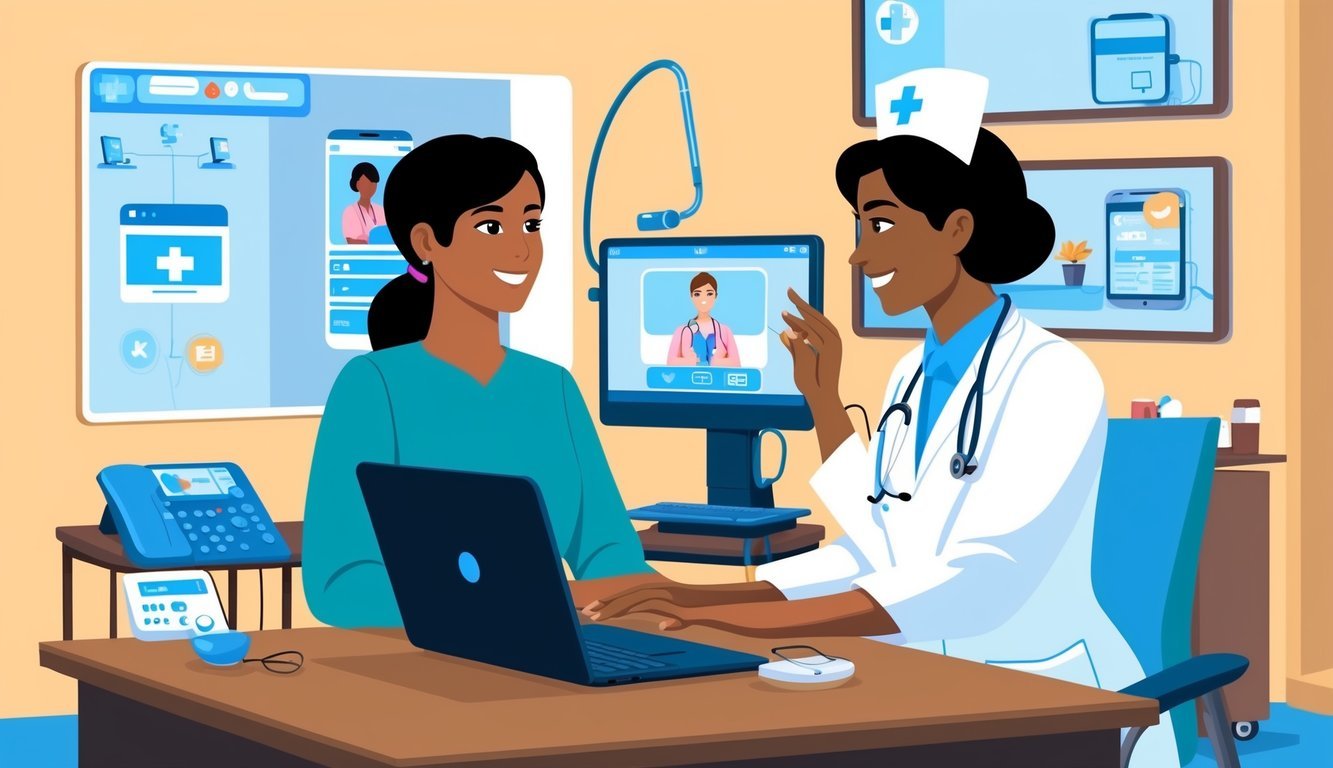Telehealth nurse practitioner jobs are rapidly growing in popularity and importance, offering flexible career options for healthcare professionals. These positions enable you to provide care remotely, meeting the increasing demand for accessible healthcare services.
With advancements in technology and changing patient needs, this field presents exciting opportunities for nurse practitioners to make a significant impact.
As a nurse practitioner, you can engage in diverse roles ranging from patient consultations to chronic disease management.
Telehealth jobs not only allow you to work from various locations but also to cater to patients who might otherwise have trouble accessing healthcare services.
Understanding the requirements and trends of telehealth nursing can help you navigate this evolving job market effectively.
As you explore this field, you may have questions about what it takes to succeed and the types of roles available.
In the following sections, you will find essential insights and tips to help you thrive in the world of telehealth nursing.
Key Takeaways
- Telehealth nursing is a growing field that offers flexible job options for nurse practitioners.
- Essential skills include effective communication and the ability to utilize technology for patient care.
- The telehealth job market is expanding, with various roles in demand for quality healthcare service delivery.
Emerging Trends in Telehealth Nursing
Telehealth is transforming how healthcare is delivered, making it more accessible.
As you explore telehealth nursing roles, it’s important to consider how they integrate with primary care and affect patient visits.
Role of Telehealth in Primary Care
Telehealth is becoming a crucial part of primary care.
It allows you to consult with patients remotely, helping those who may face barriers to in-person visits.
This includes individuals in rural areas or those with mobility challenges.
Many primary care providers, including telemedicine nurse practitioners, are adopting platforms like Televisit MD to facilitate virtual appointments.
These sessions can cover routine check-ups, follow-ups, and urgent care, ensuring that patients still receive timely medical attention.
The convenience of telehealth encourages more patients to seek care.
With more accessible options, you can deliver effective care, adjust treatment plans, and provide education without the limitations of traditional visits.
Impact of Telehealth on Patient Visits
Telehealth significantly alters the dynamics of patient visits.
One key benefit is reduced travel time, which can lead to increased patient satisfaction.
Patients can schedule appointments that fit their lifestyle.
This flexibility often leads to higher attendance rates for check-ups and follow-ups.
Additionally, your use of telemedicine can promote regular communication with patients, ensuring they feel supported in managing their health.
While the convenience is notable, it’s essential to remember that not all health issues can be addressed through telehealth.
For complex cases, in-person visits may still be necessary.
Balancing telehealth and traditional visits means you can provide comprehensive care that meets all patient needs efficiently.
Requirements for Telehealth Nurse Practitioners

As a telehealth nurse practitioner, you must meet specific educational and licensing requirements to provide quality care remotely.
Understanding these requirements is essential for a successful career in this field.
Educational and Certification Pathways
To become a telehealth nurse practitioner, you typically need a Master of Science in Nursing (MSN) or a Doctor of Nursing Practice (DNP).
Your education should focus on advanced practice registered nursing (APRN) skills.
You may choose to specialize as a Family Nurse Practitioner (FNP) or an Adult Nurse Practitioner (ANP).
Completing an accredited program is crucial.
After earning your degree, you will need to obtain certification through an organization like the American Nurses Credentialing Center (ANCC) or the American Association of Nurse Practitioners (AANP).
Continuing education is also important.
Telehealth guidelines and technologies evolve, so staying updated through workshops or online courses enhances your skills.
Licensing Across the United States
Licensing for telehealth nurse practitioners varies by state.
You must hold a valid nursing license as a registered nurse (RN) in the state where you practice.
If you are an APRN, additional requirements may apply.
Some states recognize nursing licenses from other states through the Nurse Licensure Compact (NLC).
If your state participates in this agreement, you can work in multiple states without needing separate licenses.
Check with state boards of nursing for specific regulations.
Familiarizing yourself with these requirements ensures compliance and helps you avoid legal issues while practicing telehealth.
Types of Telehealth Nursing Jobs
Telehealth nursing offers a variety of roles that cater to different needs and specialties.
Understanding the types of positions available can help you find the best fit for your career.
Contract-Based Telehealth Roles
In this type of position, you work on a contractual basis, which provides flexibility.
Contract-based roles often focus on specific projects or time frames.
Typical examples include:
- Medical Provider: Offering specific services as needed.
- Telemedicine consults for urgent cases.
Contract roles can also be advantageous in terms of pay.
They often offer higher hourly rates, which can range from $60 to $80.
However, keep in mind that benefits might not be provided.
Part-Time and Full-Time Opportunities
These roles vary based on your availability and preference.
Part-time opportunities are popular among professionals balancing other responsibilities.
These roles usually demand 10 to 20 hours a week.
Full-time positions generally require a commitment of 30-40 hours weekly.
Common responsibilities in these roles include:
- Providing virtual primary care as a registered nurse or nurse practitioner.
- Managing chronic conditions through ongoing telehealth sessions.
These roles offer stability and often come with benefits, depending on the employer.
Specializations in Telehealth Nursing
Telehealth nursing allows you to focus on various specializations.
This can enhance your skills and broaden your career options.
- Psychiatric Nurse Practitioner: Focuses on mental health assessments and treatments.
- Pediatric Care Provider: Addresses health concerns specific to children through virtual visits.
Specializing can lead to higher demand for your services.
It can also provide opportunities for professional development.
Many employers appreciate specialized skills, making you a more competitive candidate in the job market.
The Telehealth Job Market
The telehealth job market offers various opportunities for nurse practitioners.
With the rise of remote healthcare, knowing how to navigate your job search and the benefits of applying early can boost your chances of success.
Navigating the Job Search
When searching for telehealth nurse practitioner jobs, consider setting up job alerts on platforms like Indeed or Glassdoor.
These sites provide updated listings tailored to your preferences.
Create a strong resume that highlights your telehealth experience.
Emphasize skills like communication and tech-savviness since remote jobs often require proficiency with digital healthcare tools.
Networking is equally important.
Join online communities such as LinkedIn groups dedicated to telehealth professionals.
Engage in discussions to build connections and learn about hidden job opportunities.
Early Applicant Advantages
Applying early for telehealth nurse practitioner jobs can provide significant benefits.
Many employers start screening candidates as soon as they post a job.
Being among the first to apply can increase your visibility in a crowded market.
Early applicants are often viewed as more enthusiastic and committed.
This can set you apart from others who apply later.
Consider tailoring your application for each position to showcase why you’re a great fit.
Highlight relevant certifications or telehealth training, which can strengthen your application.
Remember that some positions may close quickly, so acting fast and being proactive can lead to better job outcomes.
Enhancing Telehealth Services

To improve the quality and effectiveness of telehealth services, integrating personalized health partners and advancements in virtual primary care is essential.
These approaches can significantly enhance patient engagement and satisfaction.
Integrating Personalized Health Partners
You can work with personalized health partners to tailor healthcare solutions for each patient.
This collaboration helps to develop specific care plans based on individual needs.
Benefits of Personalized Health Partnerships:
- Custom Care: By analyzing patient history and preferences, personalized care plans can be created.
- Increased Engagement: Patients usually feel more involved in their care, leading to better adherence to treatment.
Organizations like Communicare Health Services focus on creating customized telehealth solutions.
They can help you identify the right partnerships to maximize patient care.
Advancements in Virtual Primary Care
Virtual primary care is evolving, making it easier for you to provide comprehensive services remotely.
This area utilizes technology to facilitate patient interactions with healthcare providers.
Key Advancements:
- Expanded Access: Patients can receive care from the comfort of their homes, reducing barriers to healthcare.
- Integrated Technology: Tools like electronic health records (EHR) allow you to have richer, more informed interactions with patients.
By staying updated on the latest advancements, you can enhance your telehealth practice significantly.
Adopting new technologies and processes will ensure you provide the best possible care.
Frequently Asked Questions

In this section, you will find key information about telehealth nurse practitioner jobs.
This covers qualifications, salary comparisons, best practices, finding positions, part-time opportunities, and challenges in the field.
What qualifications are required to become a telehealth nurse practitioner?
To become a telehealth nurse practitioner, you typically need to complete a Master’s degree in nursing (MSN) or a Doctor of Nursing Practice (DNP).
You must hold a registered nurse license and obtain board certification as a nurse practitioner in your specialty area, such as family or pediatric nursing.
How do telehealth nurse practitioner salaries compare to traditional NP roles?
Telehealth nurse practitioners often earn competitive salaries similar to traditional nurse practitioners.
According to recent reports, the average salary for a telehealth NP ranges from $90,000 to $130,000 annually, depending on experience and location.
What are the best practices for a nurse practitioner providing remote telehealth services?
When providing remote telehealth services, it’s important to establish clear communication with your patients.
Use simple language and ensure that patients understand the information shared.
Additionally, maintain patient confidentiality and comply with HIPAA regulations to protect sensitive health information.
How does one find telehealth nurse practitioner positions in a specific region, like Seattle, WA?
To find telehealth nurse practitioner positions in Seattle, WA, utilize online job boards like Indeed and LinkedIn.
You can also check hospital and clinic websites for open positions and network with local healthcare professionals.
Local nursing organizations may have resources to help you find job openings in telehealth.
What are the part-time opportunities available for nurse practitioners in telehealth?
Part-time opportunities for nurse practitioners in telehealth are becoming more common.
Many healthcare providers offer flexible schedules for telehealth services, allowing you to work part-time while managing other commitments.
Consider roles in urgent care, mental health support, or chronic disease management, which often have part-time positions available.
What are the challenges associated with telehealth nursing?
Telehealth nursing can present several challenges.
You may face technical issues, such as connectivity problems or software glitches, which can disrupt consultations.
Additionally, building rapport with patients remotely can be more difficult than in-person interactions.
This requires strong communication skills and techniques to create trust.

